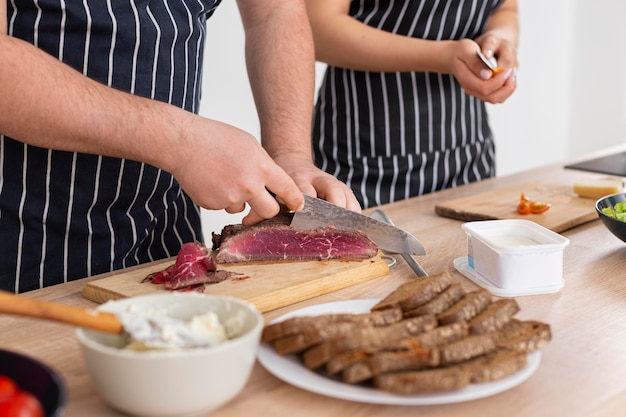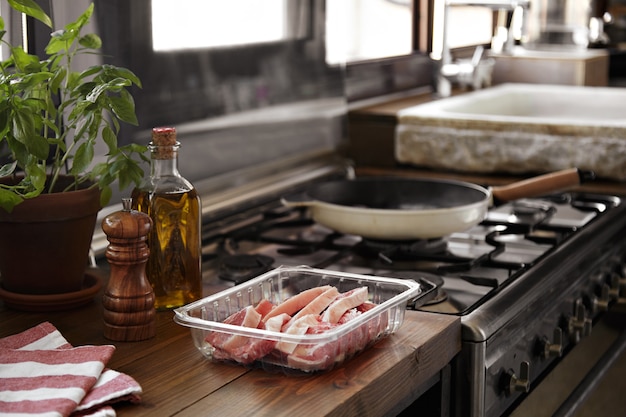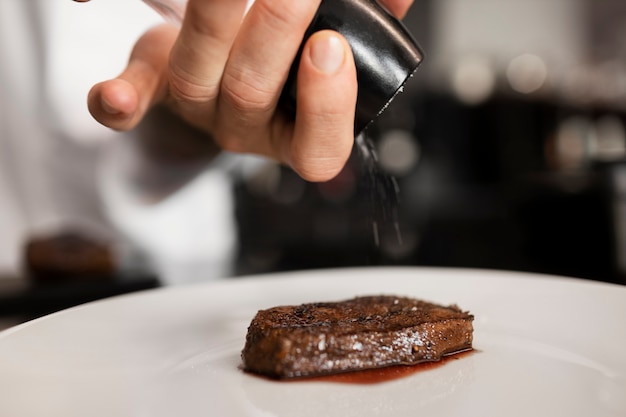Let's be honest, meatloaf gets a bit of a bad rap. It's often seen as a relic of the past, a dish best left to our grandmothers. But here's the thing: meatloaf can be absolutely delicious, and it's a real crowd-pleaser. It's one of those dishes that brings back memories of home-cooked meals and family gatherings. But, here's the catch: getting the meatloaf temperature just right is key to achieving that perfect, juicy, and flavorful result. You see, I've been there, done that with meatloaf. I've had my fair share of dry, crumbly disasters. I've also had moments of pure triumph, where the meatloaf was so succulent and flavorful that it disappeared in seconds. And the difference? You guessed it: temperature. So, buckle up, because I'm going to share all my secrets on how to nail that perfect meatloaf temperature every time.
Part 1: Understanding the Basics

Before we jump into the nitty-gritty of meatloaf temperature, let's lay down some groundwork. Why is temperature so crucial when it comes to meatloaf? It all comes down to the science of protein. When you cook meat, the proteins within the muscle fibers begin to denature and change their structure. This process is what gives meat its characteristic texture and flavor. Think about the difference between a perfectly cooked steak and a tough, dry one – that's all down to protein denaturation! But if you overcook meat, the proteins can become tough and dry, leaving you with a disappointing meal. That's where the magic of temperature control comes in. It's all about finding that sweet spot where the proteins are cooked through, but still juicy and tender.
The Danger Zone
Before we even talk about the perfect meatloaf temperature, we need to understand the "danger zone." This is the temperature range (between 40°F and 140°F) where bacteria can multiply rapidly and make you ill. It's crucial to keep your meatloaf at a safe temperature during preparation and cooking. That's why it's so important to use a thermometer! It's not just about making your meatloaf taste good, it's about ensuring it's safe to eat.
Meatloaf Temperature and Safety
The USDA recommends cooking meatloaf to an internal temperature of 160°F (71°C) to ensure it's safe to eat. But, we're not just aiming for safety here, we're aiming for deliciousness. And that's where our journey to the perfect meatloaf temperature begins.
Part 2: The Perfect Meatloaf Temperature

Now, let's get to the heart of the matter: what is the ideal meatloaf temperature for a delicious result? Well, it's not just one single number, it's a range, and it's going to depend on your personal preferences. But here's what I've learned over the years, through countless meatloaf experiments:
The Goldilocks Zone
For me, the perfect meatloaf temperature is around 155°F (68°C). It's cooked through, but it still retains its juiciness and tenderness. The meat is firm enough to slice easily, but it still melts in your mouth. Now, some people prefer a slightly higher temperature, like 160°F (71°C), for a firmer texture. Others might go for a slightly lower temperature, like 150°F (65°C), for a more melt-in-your-mouth experience. It all comes down to personal preference, so don't be afraid to experiment and find what you like best.
The Importance of Resting
Think of resting your meatloaf like letting a good wine breathe. It's crucial for allowing the juices to redistribute throughout the loaf, resulting in a more flavorful and tender final product. Once your meatloaf has reached its desired internal temperature, take it out of the oven and let it rest for about 10 minutes before slicing. I usually cover my meatloaf with foil while it rests, to keep it warm and prevent it from drying out. If you're worried about it cooling too quickly, simply put it on a wire rack to allow the heat to dissipate evenly.
Using a Thermometer
Now, let's talk about thermometers. Don't just trust your gut feeling when it comes to meatloaf. Use a good quality meat thermometer, and insert it into the thickest part of the loaf to get an accurate reading. There are different types of thermometers available, like instant-read thermometers, digital thermometers, and oven thermometers. I personally prefer the instant-read thermometers because they are quick and easy to use. Plus, they give you an instant reading, so you don't have to wait around for a digital thermometer to beep.
Part 3: meatloaf recipe and Tips

Now, let's dive into a meatloaf recipe. This is my go-to recipe, and it always produces delicious results:
Ingredients:
- 1.5 lbs ground beef
- 1/2 cup breadcrumbs (I like to use panko breadcrumbs for a slightly crispier crust)
- 1/4 cup milk (you can also use buttermilk for a tangier flavor)
- 1 egg (for binding and richness)
- 1/2 cup chopped onion (adds a sweet and savory flavor)
- 1/4 cup chopped green bell pepper (adds a bit of sweetness and color)
- 1 teaspoon salt (adjust to taste)
- 1/2 teaspoon black pepper (adjust to taste)
- 1/2 teaspoon garlic powder (for a hint of garlic flavor)
- 1/4 teaspoon onion powder (for added onion depth)
- 1/2 cup ketchup (for a classic sweet and tangy glaze)
- 1 tablespoon brown sugar (for a hint of sweetness)
Instructions:
1. Preheat oven to 350°F (175°C). This ensures your meatloaf cooks evenly.
2. In a large bowl, combine ground beef, breadcrumbs, milk, egg, onion, green pepper, salt, pepper, garlic powder, and onion powder. Mix well with your hands. Make sure the ingredients are evenly distributed.
3. Form the mixture into a loaf shape and place in a baking dish. You can use a loaf pan for a neater shape, or you can simply form it freehand in a baking dish. Spread the ketchup and brown sugar mixture over the top.
4. Bake for 1 hour and 15 minutes, or until the internal temperature reaches 155°F (68°C). This is where your trusty thermometer comes in handy. You can also use a toothpick or skewer to check for doneness. If it comes out clean, it's done.
5. Let the meatloaf rest for 10 minutes before slicing and serving. This allows the juices to redistribute and prevents the meatloaf from being dry.
Tips:
- For added flavor, you can add a few slices of bacon to the bottom of the baking dish before adding the meatloaf. The bacon fat will add richness and flavor to the meatloaf as it cooks.
- To keep the meatloaf moist, you can add a little bit of water or broth to the bottom of the baking dish. The liquid will steam the meatloaf as it cooks, helping to keep it juicy.
- If you want a crispy crust, you can broil the meatloaf for a few minutes at the end of cooking. Just watch it carefully, so it doesn't burn.
- For a vegetarian version, you can substitute the ground beef with a mixture of ground vegetables and breadcrumbs. You can use a mixture of chopped mushrooms, carrots, and zucchini, along with some oats or breadcrumbs for binding.
meatloaf variations
Now, meatloaf is a very versatile dish. You can easily customize it to your liking with different ingredients and flavors. Here are some variations you might like to try:
- Italian Meatloaf: Add chopped italian sausage, grated Parmesan cheese, and fresh herbs like basil and oregano. This variation is perfect for those who love Italian flavors.
- Tex-Mex Meatloaf: Mix in chopped jalapenos, diced tomatoes, and cumin for a spicy kick. This version is perfect for those who love a little heat.
- Cheesy Meatloaf: Add shredded cheddar or mozzarella cheese to the mixture for a gooey and satisfying center. This is a crowd-pleasing classic that's sure to be a hit.
- Mushroom Meatloaf: Stir in chopped mushrooms and a splash of soy sauce for an earthy and savory flavor. This is a great option for mushroom lovers.
Part 4: Troubleshooting Meatloaf Problems
Let's be honest, sometimes things don't go according to plan. You might end up with a dry, crumbly meatloaf, or one that's still raw in the middle. But don't despair! Here are some tips to troubleshoot common meatloaf problems:
Meatloaf Is Dry
If your meatloaf is dry, the most likely culprit is overcooking. Next time, aim for a lower internal temperature, like 150°F (65°C), and check the doneness earlier. Also, make sure to use enough moisture in your mixture. Adding milk, breadcrumbs, and chopped vegetables will help keep the meatloaf juicy. You can also try adding a bit of broth or water to the bottom of the baking dish before you bake the meatloaf.
Meatloaf Is Crumbly
If your meatloaf is falling apart, it's likely because the mixture isn't binding well. You can add a little more breadcrumbs or egg to help hold it together. Alternatively, you can use a meatloaf pan, which has a removable bottom that helps prevent the meatloaf from sticking and breaking apart. You can also try using a different type of ground beef, like a higher fat percentage (like 80/20) to add more moisture and binding.
Meatloaf Is Raw In The Middle
If your meatloaf is raw in the middle, it's simply not cooked through. You'll need to bake it for a little longer, checking the internal temperature every 10 minutes. And, of course, make sure your oven is preheated to the correct temperature. If your oven isn't heating properly, it could be the reason why your meatloaf is not cooking evenly.
Meatloaf Is Too Dense
If your meatloaf is too dense, it might be because you've used too much ground beef. Try using a leaner ground beef, like 90/10, or adding some ground pork or veal to the mixture. Also, consider adding some chopped vegetables for extra moisture and texture. The extra moisture and air pockets from the vegetables will help to prevent the meatloaf from being too dense.
Part 5: Serving Your Meatloaf Masterpiece
Your meatloaf is cooked to perfection, rested, and ready to be devoured. But what to serve it with? Here are some ideas for pairing your meatloaf with delicious sides:
Classic side dishes
- mashed potatoes: This classic pairing is always a winner. Serve them with a dollop of butter and a sprinkle of parsley. The creamy texture of mashed potatoes complements the savory flavor of meatloaf beautifully.
- green beans: Steamed or roasted green beans are a healthy and refreshing accompaniment to meatloaf. They add a touch of freshness and a bit of green to the plate.
- Gravy: A rich gravy made from pan drippings or broth will elevate your meatloaf to new heights. The gravy adds extra richness and moisture to the meal.
- Cornbread: The slightly sweet taste of cornbread complements the savory flavor of meatloaf perfectly. The texture of the cornbread also provides a nice contrast to the meatloaf.
Creative Side Dishes
- Roasted Root Vegetables: roasted carrots, parsnips, and potatoes add a delightful sweetness and earthiness to the meal. They also add a beautiful color to the plate.
- Glazed Carrots: Try honey-glazed carrots or maple-glazed carrots for a touch of sweetness and a beautiful presentation. The glaze adds a touch of shine and visual appeal to the dish.
- potato salad: A creamy potato salad with dill or mustard will balance the richness of the meatloaf. The tangy flavor of the potato salad cuts through the richness of the meatloaf.
- Fresh Salad: A simple green salad with a vinaigrette dressing will add a refreshing contrast to the hearty meatloaf. The salad adds a touch of lightness and freshness to the meal.
Part 6: Leftover Meatloaf Ideas
Got leftover meatloaf? Don't let it go to waste! Here are some delicious ways to use it up:
Meatloaf Sandwiches
Slice the meatloaf and serve it on toasted bread with your favorite toppings, like cheese, pickles, and lettuce. My favorite way to do this is with toasted sourdough bread with a slice of cheddar, a dollop of mustard, and a little bit of lettuce. The sourdough bread adds a nice tangy flavor to the sandwich.
Meatloaf Shepherd's Pie
Crumble the leftover meatloaf and use it as the base for a comforting shepherd's pie. Top with mashed potatoes and bake until golden brown. The meatloaf adds a savory flavor to the shepherd's pie, and the mashed potatoes provide a comforting topping.
Meatloaf Chili
Dice the leftover meatloaf and add it to a pot of chili. You can also use the meatloaf pan drippings to add extra flavor. The meatloaf adds a hearty texture and flavor to the chili.
Meatloaf stuffed peppers
Hollow out some bell peppers and fill them with a mixture of leftover meatloaf, rice, and cheese. Bake until the peppers are tender. The meatloaf adds a savory filling to the peppers, and the rice and cheese provide a comforting and flavorful combination.
Meatloaf Quiche
Crumble the leftover meatloaf and add it to a quiche filling with eggs, cheese, and vegetables. Bake until the quiche is set. The meatloaf adds a savory flavor to the quiche, and the eggs, cheese, and vegetables provide a hearty and flavorful filling.
Part 7: FAQs
Now, I know you might have some questions about meatloaf temperature. So, let's address them:
1. Can I use a digital thermometer instead of an instant-read thermometer?
Absolutely! Both types of thermometers are reliable for measuring meatloaf temperature. You can use whichever one you prefer. Digital thermometers are great for getting a more precise reading and they are often easier to read. Instant-read thermometers are great for getting quick readings, so they are ideal if you want a fast and accurate temperature reading.
2. What if I don't have a meat thermometer?
If you don't have a thermometer, you can use the "touch test." Press the center of the meatloaf. It should be firm, but not springy. You can also use a skewer. Insert a skewer into the center of the meatloaf. If it comes out clean, it's done. However, keep in mind that these methods are less reliable than using a thermometer. If you're unsure about the doneness, it's always best to err on the side of caution and cook it for a few minutes longer.
3. How can I make sure my meatloaf is cooked all the way through?
To ensure your meatloaf is cooked all the way through, use a meat thermometer and check the internal temperature in the thickest part of the loaf. Make sure it reaches at least 160°F (71°C) for safety. Also, consider baking it for a little longer if you're worried about it not being cooked through. You can always check the internal temperature again with a thermometer.
4. What's the best way to store leftover meatloaf?
Leftover meatloaf should be refrigerated in an airtight container within two hours of cooking. You can store it in the fridge for up to 3-4 days. Reheat it thoroughly before serving.
5. Can I freeze leftover meatloaf?
Yes, you can freeze leftover meatloaf for up to 2-3 months. Wrap it tightly in plastic wrap or aluminum foil, then place it in a freezer-safe bag. Thaw the meatloaf in the refrigerator overnight before reheating it.
Part 8: Final Thoughts
So there you have it! My secrets to achieving the perfect meatloaf temperature and creating a delicious masterpiece that will leave everyone wanting more. Remember, it's all about finding that sweet spot between safety and flavor. Don't be afraid to experiment and find what works best for you. And most importantly, have fun with it! Cooking should be an enjoyable experience, so go ahead and unleash your inner chef. Happy meatloaf-making!
Everyone is watching

How to Cook Frozen Lobster Tails Perfectly: A Step-by-Step Guide
RecipesLobster. Just the word conjures up images of lavish meals, special occasions, and a taste of luxury. But let's...

Pork Fillet Cooking Time: How Long to Cook It Perfectly
RecipesPork fillet, or tenderloin as it's sometimes called, is a real favourite in our house. It's so versatile, and...

Pigs in a Blanket Cooking Time: How Long to Bake for Perfect Results
RecipesAh, pigs in a blanket. Just the name conjures up images of those delightful little parcels of crispy pastry en...

The Ultimate Guide to Cooking Delicious Frankfurters
RecipesLet's face it, we all love a good frankfurter. It's a classic, simple, and always satisfying. But let's be rea...

Wolf Meat Recipes: A Guide to Cooking Wild Game
RecipesLet's be honest, you don't see wolf meat at your local butcher shop every day. It's a bit of a wild card, but ...
